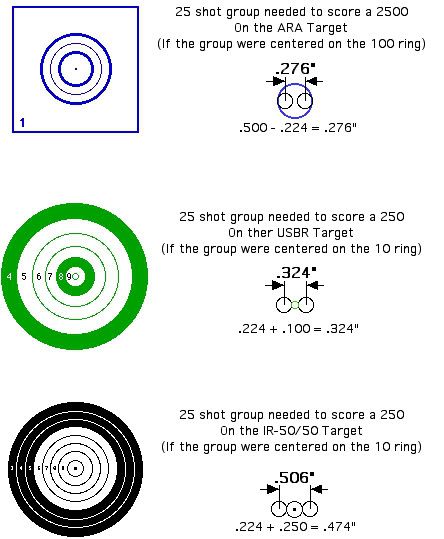Okay, if the above is true, we have one more problem.
No one is going to be willing to shoot 25 shot groups for determination of firearm accuracy or ammo testing.
I hope everyone is aware of the nature of group enlargement with the addition of each shot. I think we all know 2 shot groups will be smaller that 3 shot groups, 3 shots smaller than 5 shots, 5 shots smaller than 10 shots, etc.
Without doing a detailed statistical analysis for the group growth of 5 vs 25 shots, I’ll just make an educated guess which could be wrong and estimate that size as being somewhere in the low .2’s.
I have to go to work, so maybe someone else can jump in with a closer number.
Does this make sense to anybody or have I made any obvious errors?
HuskerP7M8,
Not too long ago I did a calculation that can be used to address the question of how group size (extreme spread) depends on the number of shots in the group. I'm not a competition shooter, but I read this forum sometimes because I'm interested in the application of statistics and probability to shooting. So, when I saw your comment I thought maybe I could contribute something useful, which also has some connection to Bored184's question.
There are a couple of complications so bear with me. First the situation is complicated by the fact that the most common way to measure group size is extreme spread, ES (the distance between the two most widely separated holes). This is fine for scoring targets, but if you want to say anything about expected (that is, predicted) average group size for a shooter and/or equipment, it is a very poor statistic to use. For one thing as you pointed out it varies with the number of shots, and for another, just the natural random differences between groups will cause it (extreme spread aka group size) to vary substantially between groups even if they are effectively shot under identical conditions.
So, to see how group size varies you need something more constant to compare it against. There is a statistic which for the sake of discussion I'll call the "true group size" or TGS, which is completely independent of the number of shots in the group and so is a good description of average group size produced by a particular combination of shooter, rifle, load, etc. Rather than get into the details of that statistic here, I'll just say it exists and can be calculated.
Given all of this, the question of how group size/ES grows with increasing number of shots has to be answered in probabilities. I have a web page that lets people do the extreme spread (group size) probability calculation for different numbers of shots in a group and below I've listed probabilities of getting a group size (ES) greater than the "true group size" TGS, for 5, 10, and 25 shot groups. Remember, TGS (true group size) is a fixed size, independent of the number of shots in the group, ES will vary from group to group.
5 shot group
94.4% chance that ES > TGS
36.4% chance that ES > 1.5 x TGS
3.84% chance that ES > 2 x TGS
10 shot group
more than 99.99% chance that ES > TGS
86.9% chance that ES > 1.5 x TGS
16.2% chance that ES > 2 x TGS
25 shot group
more than 99.99% chance that ES > TGS
more than 99.99% chance that ES > 1.5 x TGS
64.1% chance that ES > 2 x TGS
So this tells you that for a 25 shot group the chance of seeing a group size more than twice as big as the TGS is 61.1/3.84 or about 16 times the chance of seeing that group size for a 5 shot group.
Keep in mind that if the conditions (barrel cleanliness, temp., etc.) are effectively the same, then five 5-shot groups are equivalent to one 25-shot group. This tells you a lot about "flyers".
I've left out some details and could fill them in if anyone is interested.




